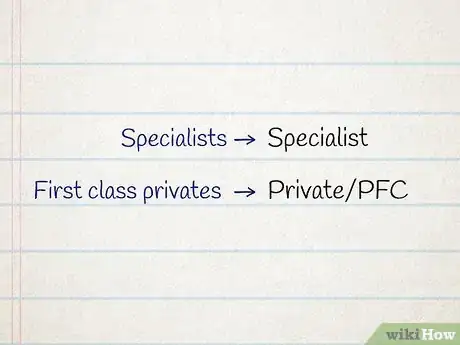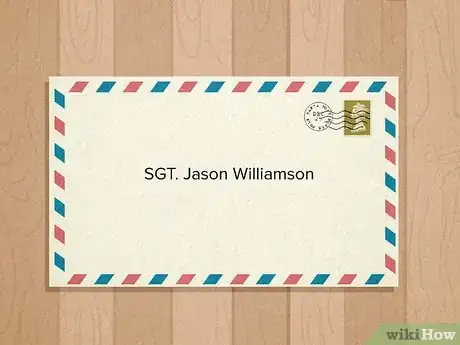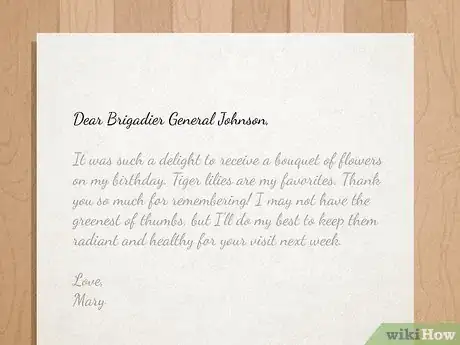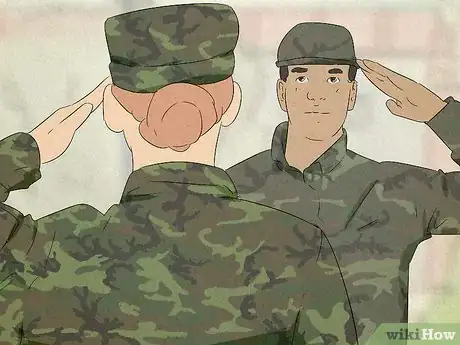This article was co-authored by wikiHow staff writer, Eric McClure. Eric McClure is an editing fellow at wikiHow where he has been editing, researching, and creating content since 2019. A former educator and poet, his work has appeared in Carcinogenic Poetry, Shot Glass Journal, Prairie Margins, and The Rusty Nail. His digital chapbook, The Internet, was also published in TL;DR Magazine. He was the winner of the Paul Carroll award for outstanding achievement in creative writing in 2014, and he was a featured reader at the Poetry Foundation’s Open Door Reading Series in 2015. Eric holds a BA in English from the University of Illinois at Chicago, and an MEd in secondary education from DePaul University.
There are 15 references cited in this article, which can be found at the bottom of the page.
This article has been viewed 40,677 times.
Learn more...
Knowing how to address service members can be a little tricky. The ranks themselves can be a bit wordy and convoluted, and some ranks are addressed by shortened titles. The good news is that a lot of the titles are pretty easy to figure out if you know a service member’s rank. Even if you don’t know their rank, you can always use “sir” or “ma’am” to play it safe. Remember, the only time you ever use a service member’s full title is in the salutation of a letter or email. Any other time, you use their official title of address.
Steps
Selecting the Proper Title
-
1Use the formula of title of address + last name to address service members. Regardless of whether you’re enlisted or not, you always address a service member by their rank’s title of address, followed by their last name. Title of address refers to the official designation for addressing a given rank.[1]
- In some cases, like for majors, the rank and the type of address are identical. A major named Angie Nunez would be addressed, “Major Nunez.”
- For some ranks, like lieutenant colonels, the title of address is different. If there were a lieutenant colonel named Andrew Bates, they would just be “Colonel Bates.”
-
2Shorten high ranking officials to the main rank when addressing them. If a ranking service member holds a position that’s more than 1 word long (i.e. “brigadier general”), you address them by shortening it to the highest position in that title. For example, a lieutenant is lower than a colonel, so you would address a lieutenant colonel simply by “Colonel.”[2]
- Address generals as “General” regardless of their stars or status. Major generals, brigadier generals, and one-star generals are all addressed as “General.”
- Call Colonels and Lieutenant Colonels “Colonel.”
- Address First and Second Lieutenants as “Lieutenant.”
- Call Majors “Major.”
- Address Captains as “Captain.”
Advertisement -
3Be specific when addressing Sergeants if you know the full rank. The one group of ranking officers that doesn’t follow the standard title of address rules are sergeants. Here are the rules when it comes to addressing sergeants:[3]
- You call first class sergeants, staff sergeants, and master sergeants simply “Sergeant” with no modifiers or descriptors.
- Sergeant majors always get the full title, “Sergeant Major.”
- First sergeants also get the full title and they go by “First Sergeant.”
-
4Use the special Navy and Coast Guard titles if applicable. There are a handful of ranks that are unique to the Coast Guard and Navy. Some of these ranks are fairly niche, but you should still use the proper title of address when talking to service members in these branches.[4]
- Admirals and commanders all follow the same rules as generals. A brigadier admiral is addressed “Admiral” while a lieutenant commander just goes by “Commander.”
- Gendered ranks in the Navy are no longer used. The official way to address seamen and midshipmen is to call them “Sailor.”[5]
- Ensigns all go by “Ensign.”
-
5Address all privates and specialists by their base title. There are various classes and pay grades for privates. Luckily, they’re all addressed the same way regardless of their pay grade or position. You call them “Private.”[6]
- Regardless of the specialty, all specialists go by “Specialist.”
- You get a choice with first class privates. You can either call them “Private,” or address them as “PFC,” which is short for “private first class.”
-
6Skip the title when you’re addressing warrant officers. Warrant Officers do not get a special title. Address them as Mister, Miss, or Misses depending on their personal preferences.[7]
- Warrant officers work in technical fields, like intelligence. You probably aren’t going to run into very many warrant officers.[8]
Writing Letters and Emails
-
1Use the rank’s shorthand when addressing letters to service members. If you’re addressing a physical letter to a service member, you don’t have to spell out the entire title in the body of the message or on the envelope. In these cases, use the shorthand. The official shorthand’s do not always correlate to the title of address, so look it up online if you aren’t sure.[9]
- For example, a brigadier general’s title of address is just “General,” but their abbreviation is “Brig. Gen.” If you were to write a letter to a brigadier general named Jay Brooke, you would write, “Brig. Gen. Jay Brooke.”
- Titles with “first” or “second” in them typically use the number for the abbreviation. A first lieutenant, for example, is abbreviated as “1st Lt.”
- You can use whatever subject line you’d like if you’re emailing a service member.
-
2Include the unit designation, PO box, and designator on the delivery line. For letters, you do not include the country or city where the service member is located. You do include the ZIP code, though. There are a few unique things you must put on the delivery line to make sure the letter reaches its recipient.[10] Here’s how it looks:
- On the line under the shorthand rank and recipient’s name, put UNIT, CMR (community mail room), or PSC (postal service center) followed by that destination’s number. On the same line, write “BOX” followed by the PO box number.
- On the bottom line, put APO (Army Post Office) or FPO (Fleet Post Office), followed by AA (for American service members) and the ZIP code.
- All together, it should look like this:
- SGT. Jason Williamson
- UNIT 2913 BOX 150
- APO AA 89049
-
3Spell out the entire rank in the salutation of a letter or email. Do not use the title of address in the salutation of a letter or email. Instead, use their full title and skip the first name. For example, let’s say you’re addressing a brigadier general named Stacy Johnson. You’d put “Brigadier General Johnson,” or “Dear Brigadier General Johnson,” at the top of your message.[11]
- If you’re writing a letter or email and you’re addressing a specific service member, you capitalize the rank.[12]
- If you don’t know their full title, use “Sir,” or “Ma’am” in the salutation and don’t include their first or last name.
Talking to Military as a Civilian
-
1Greet military members using their proper title if you know it. If you know a service member’s rank, use their title of address to talk to them. It is not considered rude or disrespectful to use military terminology when you’ve never served. In fact, it’s a sign of respect![13]
- For example, you might say “Good morning, Major Stevens,” or, “How are you doing, Sergeant Jameson?”
-
2Use “sir” or “ma’am” if you don’t know their rank or title. If you aren’t sure what the service member’s rank is, just use the formal “sir” or “ma’am.” Skip the first and last names if you do this. This a sign of respect for service members, probably because it’s the same rule service members use to talk to outranking officers. You can always ask a service member’s official rank later if you’re chatting with them.[14]
- For example, if you’re standing in line at the bank or something and there’s a uniformed service officer standing next to you but you don’t know their rank, there’s nothing wrong with saying, “How are you doing, sir?”
-
3Don’t salute before you address a service members. There are rules surrounding saluting when service members address officers, but as a civilian you don’t need to do this. Some service members may look at it as a sign of respect, but it isn’t expected of you.[15]
- Some service members may get annoyed if you salute them as a civilian. It’s unlikely, but since saluting is an official military gesture, they may take it as an insult.[16]
-
4Continue using their title even if they’re retired. A veteran that retired with the rank of colonel is a colonel for life. Address veterans by their official title unless they tell you otherwise.
- It’s not uncommon for a veteran to say something like, “Oh, just call me David,” or, “Mr. Ramsey is fine, I haven’t served in years.” Still, it’s better to wait for them to ask you to drop the title than it is to assume they don’t want you to use it.[17]
Addressing Personnel when You’re Enlisted
-
1Stand at attention and salute before addressing officers. If you’re actively serving and an outranking officer enters the room, stand up and enter a salute.[18] Wait for the officer to put you “at ease” or “carry on” before letting the salute down or moving.[19]
- If you’ve just joined the military and you’re still stepping on eggshells over how to speak to officers, don’t worry. All of this will all become second nature soon enough.
-
2Use “sir” or “ma’am” if they’re addressing you directly. If an officer is talking directly to you and they’re asking you a question or waiting for a response, be sure to throw a “sir” or “ma’am” in there. You can start or end the sentence with one of the terms depending on the flow of the sentence. This a sign of respect and you may run into trouble if you talk to an officer too casually.[20]
- For example, you might say, “Sir, the barracks have been cleaned,” or, “The barracks have been cleaned, sir.” Both are acceptable.
- Avoid using “sir” or “ma’am” more than once in a sentence. Aside from the fact that it sounds a little odd, it’s seen as a faux pas to overdo it.[21]
-
3Check their insignias to determine their rank based on the branch. Knowing how to address an officer depends on their rank. If you haven’t memorized the insignias for your branch yet, you will with time. The insignias are the patches on the uniform, and each branch has its own insignias for different ranks. Study your manual if you haven’t already to put the different insignias to memory.[22]
- Chevrons are the v-shaped stripes you see on patches. The more stripes on a chevron, the higher the rank of the individual wearing that uniform.[23]
- Bars are worn by officers. The size, shape, and color all indicate different ranks depending on the service branch.[24]
- Certain officers will also wear oak leaves, eagle pins, or stars.[25]
Warnings
- The Navy got rid of all gendered titles a few years ago. Unfortunately, some officers and veterans aren’t on board. Don’t get upset if you refer to someone as “Sailor” and they correct you.[28]⧼thumbs_response⧽
References
- ↑ https://www.1tsc.army.mil/Portals/35/documents/newcomers/FT_Knox_Civilian_Newcomer_Guide.pdf?ver=2018-07-25-140628-950
- ↑ https://www.1tsc.army.mil/Portals/35/documents/newcomers/FT_Knox_Civilian_Newcomer_Guide.pdf?ver=2018-07-25-140628-950
- ↑ https://www.1tsc.army.mil/Portals/35/documents/newcomers/FT_Knox_Civilian_Newcomer_Guide.pdf?ver=2018-07-25-140628-950
- ↑ https://www.militaryonesource.mil/family-relationships/spouse/military-life-for-spouses/how-military-insignia-works/
- ↑ https://www.nydailynews.com/news/national/navy-rid-gender-specific-titles-article-1.2504407
- ↑ https://www.militaryonesource.mil/family-relationships/spouse/military-life-for-spouses/how-military-insignia-works/
- ↑ https://www.1tsc.army.mil/Portals/35/documents/newcomers/FT_Knox_Civilian_Newcomer_Guide.pdf?ver=2018-07-25-140628-950
- ↑ https://www.goarmy.com/careers-and-jobs/current-and-prior-service/advance-your-career/warrant-officer.html
- ↑ https://www.taps.org/globalassets/connect/main/TAPSMagazineStyleGuideforWriters.pdf
- ↑ https://faq.usps.com/s/article/How-Do-I-Address-Military-Mail
- ↑ https://www.theclassroom.com/how-to-write-a-letter-for-an-army-officer-13583621.html
- ↑ https://www.taps.org/globalassets/connect/main/TAPSMagazineStyleGuideforWriters.pdf
- ↑ https://www.1tsc.army.mil/Portals/35/documents/newcomers/FT_Knox_Civilian_Newcomer_Guide.pdf?ver=2018-07-25-140628-950
- ↑ https://www.1tsc.army.mil/Portals/35/documents/newcomers/FT_Knox_Civilian_Newcomer_Guide.pdf?ver=2018-07-25-140628-950
- ↑ https://www.militaryonesource.mil/family-relationships/spouse/military-life-for-spouses/how-military-insignia-works/
- ↑ https://www.chicagotribune.com/news/redeye-how-to-thank-a-veteran-101-20151109-story.html
- ↑ https://www.1tsc.army.mil/Portals/35/documents/newcomers/FT_Knox_Civilian_Newcomer_Guide.pdf?ver=2018-07-25-140628-950
- ↑ https://www.military.com/join-armed-forces/getting-the-lowdown-on-customs-and-courtesies.html
- ↑ https://www.unl.edu/armyrotc/HandbookChapters/Chapter5.pdf
- ↑ https://www.1tsc.army.mil/Portals/35/documents/newcomers/FT_Knox_Civilian_Newcomer_Guide.pdf?ver=2018-07-25-140628-950L
- ↑ https://www.military.com/join-armed-forces/getting-the-lowdown-on-customs-and-courtesies.html
- ↑ https://www.defense.gov/Our-Story/Insignias/
- ↑ https://www.militaryonesource.mil/family-relationships/spouse/military-life-for-spouses/how-military-insignia-works/
- ↑ https://www.militaryonesource.mil/family-relationships/spouse/military-life-for-spouses/how-military-insignia-works/
- ↑ https://www.militaryonesource.mil/family-relationships/spouse/military-life-for-spouses/how-military-insignia-works/
- ↑ https://www.montgomeryschoolsmd.org/uploadedFiles/departments/egps/services/editorial/How%20to%20Address%20Letters%20to%20Ranking%20Members%20of%20the%20Armed%20Forces.pdf
- ↑ https://www.airforcetimes.com/news/your-air-force/2020/06/18/better-fitting-body-armor-for-female-airmen-on-the-way/
- ↑ https://www.navytimes.com/news/your-navy/2016/11/18/the-navy-took-away-sailors-job-titles-and-now-no-one-knows-what-to-call-each-other/











































































